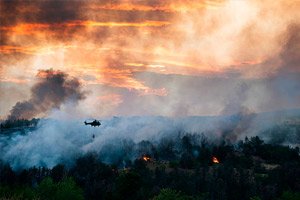
All iLive content is medically reviewed or fact checked to ensure as much factual accuracy as possible.
We have strict sourcing guidelines and only link to reputable media sites, academic research institutions and, whenever possible, medically peer reviewed studies. Note that the numbers in parentheses ([1], [2], etc.) are clickable links to these studies.
If you feel that any of our content is inaccurate, out-of-date, or otherwise questionable, please select it and press Ctrl + Enter.
Wildfire smoke hits Europe harder than thought: 93% underestimated risk
Last reviewed: 18.08.2025
 ">
">The Lancet Planetary Health published the largest European study of the short-term impact of wildfire smoke on mortality. According to data from 654 regions in 32 countries (2004-2022), each +1 μg/m³ of smoke-specific PM2.5 is associated with an increase in overall mortality by 0.7%, respiratory mortality by 1.0%, and cardiovascular mortality by 0.9%. If the risk is calculated based on “regular” PM2.5, rather than fire PM2.5, the load is underestimated by 93% (535 deaths per year versus 38).
Background
- Fires in Europe have become more frequent and intense. The 2022 season was the second worst in the EU since 2000, according to Copernicus/EFFIS, and produced record carbon emissions in Spain and France - an indicator that smoky episodes are becoming more regular amid warming.
- PM2.5 is the main “carrier” of harm from smoke. The World Health Organization has tightened air quality guidelines to 5 µg/m³ per year and 15 µg/m³ over 24 hours for PM2.5, since even low levels are associated with increased mortality.
- Fire PM2.5 may be more toxic than “regular” PM2.5. Experimental and epidemiological studies show that forest smoke particles are more likely to cause more damage to the respiratory and cardiovascular systems than equal doses of urban PM2.5, due to their composition, size, and associated chemicals. However, standards generally do not differentiate between sources of PM2.5.
- Until recently, Europe lacked accurate estimates. While global studies had linked fire PM2.5 to increased short-term mortality, data for Europe was patchy, making it difficult to accurately calculate the risk burden. A new multi-country study closes that gap.
- Why “source specificity” matters. The authors showed that using risk coefficients for “total” PM2.5 significantly underestimates smoke-related mortality; accounting specifically for wildfire-PM2.5 yields a significantly higher burden estimate. This is an argument for updating air quality monitoring/forecasting systems and population protection measures.
What did they do?
The authors used the EARLY-ADAPT database: daily death records in 654 contiguous subnational regions of Europe (≈541 million inhabitants) and daily estimates of fire and non-fire PM2.5. They built models with lags of up to 7 days to capture the delayed effect of smoke on mortality (total, respiratory, cardiovascular).
Results (Main Numbers)
- For every +1 μg/m³ wildfire-PM2.5:
- +0.7% all-cause mortality;
- +1.0% respiratory mortality;
- +0.9% cardiovascular mortality (within 7 days of exposure). - Risk underestimation: calculations with "general" PM2.5 give only 38 deaths/year, and with fire-specific - ~535/year. The gap is ≈93%.
- Where it is worst: the largest associations are Bulgaria, Romania, Hungary, Serbia; in some regions of Portugal and Spain the connections are weaker (possible effects of local fire prevention and management).
Why is this important?
- Smoke ≠ regular smog. According to a number of studies, fire PM2.5 may be more toxic than "urban" PM2.5 due to the composition and size of the particles - and the new study confirms: one risk coefficient cannot be used for all PM2.5. Source-specific assessments are needed in monitoring and health policy.
- Policy and health. Including wildfire-PM2.5 in early warning (AQI), ventilation/HEPA recommendations, and N95/FFP2 masks will help better protect vulnerable groups - the elderly, people with COPD/asthma, CVD, pregnant women. (The conclusion follows from the effect on respiratory and cardiovascular mortality.)
How does this compare to previous data?
Global and regional assessments have already shown the harm of fire PM2.5 and hinted at greater toxicity compared to non-fire sources. The European multi-country with EARLY-ADAPT provides the most detailed “portrait” to date of short-term mortality specifically from fire smoke on the continent.
Restrictions
These are time-series associations: they show short-term risks but do not explain all mechanisms or assess long-term consequences. The quality of fire inventories and fire PM2.5 modeling varies across regions; heterogeneity is influenced by adaptation measures and population structure.
Source: Alari A. et al. The Lancet Planetary Health (online, June-August 2025) - “Quantifying the short-term mortality effects of wildfire smoke in Europe”. DOI: 10.1016/j.lanplh.2025.101296
